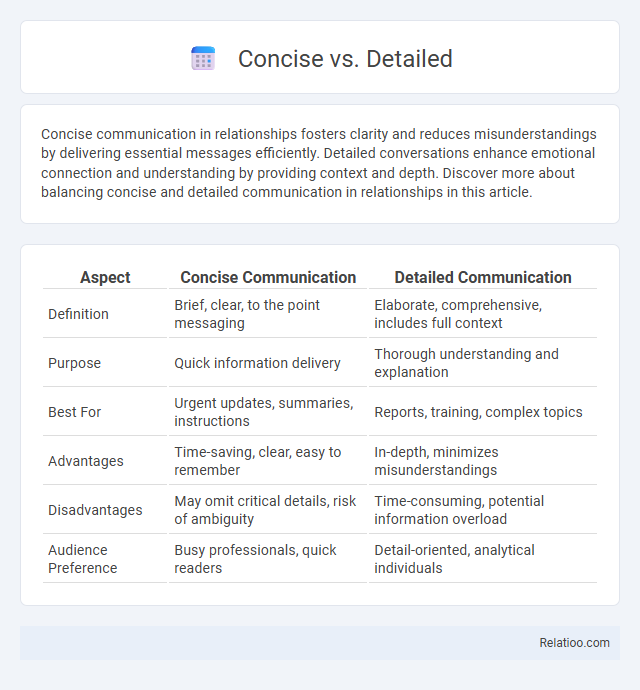Concise communication in relationships fosters clarity and reduces misunderstandings by delivering essential messages efficiently. Detailed conversations enhance emotional connection and understanding by providing context and depth. Discover more about balancing concise and detailed communication in relationships in this article.
Table of Comparison
| Aspect | Concise Communication | Detailed Communication |
|---|---|---|
| Definition | Brief, clear, to the point messaging | Elaborate, comprehensive, includes full context |
| Purpose | Quick information delivery | Thorough understanding and explanation |
| Best For | Urgent updates, summaries, instructions | Reports, training, complex topics |
| Advantages | Time-saving, clear, easy to remember | In-depth, minimizes misunderstandings |
| Disadvantages | May omit critical details, risk of ambiguity | Time-consuming, potential information overload |
| Audience Preference | Busy professionals, quick readers | Detail-oriented, analytical individuals |
Understanding Concise and Detailed Writing
Concise writing prioritizes clarity and brevity by using minimal words to convey essential information, making it ideal for quick comprehension. Detailed writing, on the other hand, provides comprehensive information with thorough explanations and examples, enhancing depth of understanding and insight. Mastering both styles allows effective communication tailored to the reader's needs, balancing precision with depth.
Key Differences Between Conciseness and Detail
Conciseness prioritizes brevity and clarity, conveying essential information with minimal words to enhance readability and comprehension. Detailed writing provides comprehensive information, including contextual and supporting data, which aids in-depth understanding but can increase length and complexity. Summarization distills content into its core points, balancing conciseness and detail by extracting the most relevant information without excessive elaboration.
Benefits of Concise Communication
Concise communication enhances clarity by presenting essential information quickly, reducing misunderstandings in professional settings. It saves time for both sender and receiver by eliminating unnecessary details and allowing for faster decision-making. Efficient communication improves productivity and ensures key messages are retained, benefiting organizations and individuals alike.
Advantages of Detailed Explanations
Detailed explanations provide comprehensive understanding by covering all relevant aspects and nuances, reducing ambiguity and enhancing clarity. They facilitate deeper learning and better problem-solving by offering context, examples, and thorough reasoning. This approach supports informed decision-making and effective communication in complex topics or technical fields.
When to Use Concise Language
Concise language is best used when communicating clear, essential information quickly, such as in instructions, executive summaries, or headlines, where brevity enhances understanding. Your audience benefits from concise language in situations requiring fast decision-making or when reading time is limited. Detailed explanations and summarizations are better suited for in-depth analysis or capturing key points, but concise language ensures clarity and efficiency in your core messaging.
Situations Requiring Detailed Responses
Situations requiring detailed responses often arise in legal, medical, or technical fields where precision and comprehensive information are critical to avoid misunderstandings or errors. You must prioritize thorough explanations and include all relevant data, ensuring the recipient fully understands the context and nuances. Detailed responses support complex decision-making by providing clarity and depth that concise or summarized replies cannot achieve.
Potential Drawbacks of Being Too Concise
Being too concise can lead to the omission of critical details, causing misunderstandings or incomplete information for decision-making. Important nuances, context, and supporting evidence may be lost, reducing clarity and the ability to fully grasp complex subjects. While conciseness enhances readability, striking a balance with sufficient detail ensures the message remains comprehensive and informative.
Pitfalls of Overly Detailed Writing
Overly detailed writing can overwhelm readers with excessive information, obscuring the main message and reducing overall clarity. This pitfall often leads to reader fatigue and diminished engagement, as important points get buried in unnecessary specifics. Effective communication balances detail with conciseness to maintain interest and ensure key insights are easily digestible.
Balancing Conciseness and Detail
Balancing conciseness and detail requires delivering essential information with clarity while avoiding unnecessary verbosity or oversimplification. Effective content synthesis uses targeted summarization techniques to retain core insights without sacrificing critical context or nuance. Optimizing this balance enhances comprehension, engagement, and retention across diverse communication platforms.
Tips for Choosing the Right Approach
Choosing between concise, detailed, and summarization approaches depends on your content's purpose and audience needs. Use concise formats for quick clarity and essential information, detailed approaches when thorough understanding is crucial, and summarization to highlight key points without overwhelming your readers. Your ideal choice balances information density with reader engagement to maximize comprehension and retention.

Infographic: Concise vs Detailed
 relatioo.com
relatioo.com